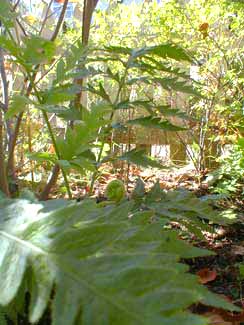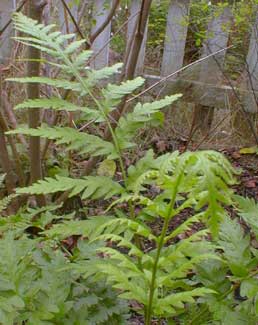
Giant Chain Fern
"In the wood the ferns unfold
Slow their fronded green,
Little misteries are told
By little tongues unseen."
-Louise Morgan Sill,
1928
1928
The giant chain fern (Woodwardia fimbriata) is suited to zones 8 or 9, demanding mild year-round weather. At its biggest, it is the largest fern that grows in North America. Its rosette of upright curved fronds typically grow three to five feet, though in the wild nine foot specimens are encountered.
 It grows from British Columbia, through the "Puget Sound trough" to Oregon, as far as southern California & Baja, & inland to Nevada & Arizona. Its range is discontinuous, with many areas where it is simply never seen.
It grows from British Columbia, through the "Puget Sound trough" to Oregon, as far as southern California & Baja, & inland to Nevada & Arizona. Its range is discontinuous, with many areas where it is simply never seen.In our state it is typically found along streams & river banks not too distant from saltwater & becomes rarer & rarer inland toward the Cascades. In some Northwest coastal locations it is found growing in considerable sunlight on moist bluffs, even though in the garden bright to moderate shade would be preferred. In its southern range it is fonder of valley streambanks & would not be as often seen on sunned bluffs.
Though it is found in our county of Kitsap, Washington, it is uncommon here as throughout the Puget Sound trough. It will multiply itself by runners but is not aggressive in its colonization & usually only a few are encountered at a time. It does not compete well with native swordfern (Polystichum munitum) which is more forgiving of imperfect conditions, & it is easily displaced by the many invasive species of weeds that have gotten loose in this region. It also vanishes out of eroded or deforested areas. It is more common in California among the redwoods.
This is the only species of Woodwardia found in Washington, & it is the only North American Woodwardia that is evergreen. It'd be just about the most beautiful large fern in North America, if not for the western swordfern that truly gives it a run for its money in terms of year-round looks. The previous year's fronds on a chain fern last until the new year's fronds are unfurling. It may need some early or mid-spring trimming to tidy it up, removing the older worn-out fronds.
It gets its name "Chain Fern" because of the chain of sori that coil about on the underside of the fronds. It wants rich loamy soil, & should never be entirely dry. It dislikes fertilizer & if it were given nitrogen it could be damaged, but an autumn/winter topcoating of well-composted manure, or leaves & leafmold, will keep its soil conditions topnotch.